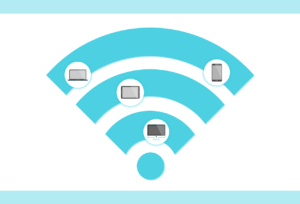
It seems almost every home has a Wi-Fi network today. Having a fast wireless network that covers your entire home is more important than ever. With smartphones, smart TVs, tablets, laptops and ‘Internet of Things (IoT)’ devices including speakers, doorbells, security cameras, baby monitors, light bulbs and more all connecting through our Wi-Fi network, we need that network to reach all corners of our home and have enough bandwidth available to handle all these devices. This article will cover some practical ways we can make the most of our Wi-Fi network.
What Affects Wi-Fi Coverage?
Modern Wi-Fi networks can reach up to 150 feet indoors and 300 feet outdoors. However, with interference from walls, windows, siding, appliances, wiring inside of walls and other wireless signals the actual range you achieve can vary greatly. The materials your walls are made out of can affect the strength of your wi-fi signal. Metal walls or siding will almost stop the signal in its tracks. Your furnace and A/C vents can also affect coverage. Aquariums will lower the signal coverage as Wi-Fi signals don’t move as freely through the water as they do in open air. Almost any electronic device in the area that gives off wireless signals will limit your network’s coverage. This includes Microwaves and cordless phones. Another factor is other wi-fi networks within reach. If you can see other networks available from your phone or laptop, they will affect your own network’s performance.
Placement Matters
More often than not, I see wireless routers stuffed away in closets, in the utility room in the basement, behind the furnace or under a desk. There’s a good reason for this too. Most routers are not the best-looking devices and they tend to have a lot of wires hanging off them. Certainly not something most people want in the middle of their dining room or living room. However, the placement of the router can be very important to your coverage.
Ideally, your router should be in a central location of your house, in the open and not too close to either the floor or the ceiling. Ideally. But guess what. My router is at one end of my house in a cabinet. Why? Simply because it gets me the coverage I need from there. I can comfortably use my laptop anywhere in my house, out on my deck and in many areas of the yard. So before you go erecting a special pedestal so your router can have a perfectly central location in your home, ask yourself if your coverage is OK as it is. Internet in every corner of your home is no good if you trip over cables each time you want a snack from the kitchen. If you aren’t happy with your wi-fi coverage, then it might be time to consider a move for your router.
Change the Channel
Wireless routers operate on channels. The more signals sharing the same channel at once, the worse each signal’s strength will be. And, most routers will use the same handful of channels by default. This means that by analyzing the wireless signals in range of your devices and switching to a less used channel, you can significantly improve the quality of your network. To find a channel with little traffic on it, you’ll need an application to check them. Here are a few you can use: Wifi Analyzer for iOS or Wifi Analyzer for Android. Look for a channel with little to no other networks on it. Changing the channel of your router is relatively easy to do. You need to visit the configuration page for your router:
|
D-Link |
|
|
Linksys |
|
|
Netgear |
|
|
Belkin |
|
|
Cisco |
|
|
Buffalo |
|
|
Telus |
|
|
Shaw |
|
Log in and look under the wireless settings for the Channel Selector, then set it to the channel you found with the least traffic.
Throw Money at the Problem
The previous tactics will help your coverage, but depending on the equipment you have and the layout and building materials of your home, you might need to do some upgrading to get whole house coverage. After all, it isn’t really feasible to change the whole layout of your home to improve wi-fi coverage. Especially since adding some equipment to your network is simpler and more economical.
If your router is an outdated 802.11b or 802.11g model, it is probably time to upgrade to a 802.11ac model or maybe even get ahead of the curve with a new WiFi 6 model. If all this is a bit confusing, that’s okay. You really only need to know that g is a newer revision than b, n is newer than g and ac is currently the newest one. Each newer one gets higher speed and longer range capabilities.
Wi-Fi repeaters or Wi-Fi range extenders can be used to pick up your signal and rebroadcast it to extend the range. This is a nice solution to if you only have one dead area in your network and it’s close enough that a Range Extender can be placed both within range of your current router and close enough to the dead zone to cover it.
If you want one of the best Wi-Fi networks available a Wi-Fi Mesh system is probably your best bet. They tend to be on the more expensive side, but are the best option for a large home or office if you want great coverage.
If you need help getting your wi-fi network up and working top notch, book an appointment below. We can help with anything from optimizing your current router’s settings to helping suggest and set up upgrades as needed.


